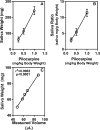A Method for the Measurement of Salivary Gland Function in Mice
- PMID: 29443033
- PMCID: PMC5828684
- DOI: 10.3791/57203
A Method for the Measurement of Salivary Gland Function in Mice
Abstract
Patients with Sjögren's syndrome, an autoimmune disease affecting the exocrine glands, develop salivary gland inflammation and have reduced saliva production. Similarly, saliva production is severely compromised in patients receiving radiation treatment for head and neck cancers. Rodent models, developed to mimic these clinical conditions, facilitate an understanding of the disease pathogenesis and allow for the development of new therapeutic strategies. Therefore, the ability to accurately, reproducibly, and repeatedly measure salivary gland function in animal models is critical. Building on procedures previously described in the literature, a method was developed that meets these criteria and was used to evaluate salivary gland function in mice. An additional advantage of this new method is that it is easily mastered, and has little inter-operator variation. Salivary gland function is evaluated as the amount (weight or volume) or rate (mL/min) of saliva produced in response to pilocarpine stimulation. The collected saliva is a good source for the analyses of protein content, immunoglobulin concentrations, and other biomolecules.
References
-
- Proctor GB. The physiology of salivary secretion. Periodontol 2000. 2016;70(1):11–25. - PubMed
-
- Fox RI. Sjögren's syndrome. Lancet. 2005;366(9482):321–331. - PubMed
-
- Eisbruch A, Kim HM, Terrell JE, Marsh LH, Dawson LA, Ship JA. Xerostomia and its predictors following parotid-sparing irradiation of head-and-neck cancer. Int J Radiat Oncol Biol Phys. 2001;50(3):695–704. - PubMed
-
- Marmary Y, Fox PC, Baum BJ. Fluid secretion rates from mouse and rat parotid glands are markedly different following pilocarpine stimulation. Comp Biochem Physiol A Comp Physiol. 1987;88(2):307–310. - PubMed
-
- Lin AL, Johnson DA, Wu Y, Wong G, Ebersole JL, Yeh CK. Measuring short-term gamma-irradiation effects on mouse salivary gland function using a new saliva collection device. Arch Oral Biol. 2001;46(11):1085–1089. - PubMed
Publication types
MeSH terms
Grants and funding
LinkOut - more resources
Full Text Sources
Other Literature Sources






